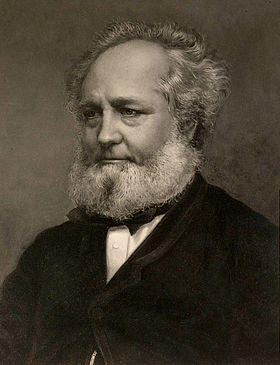John Fairfax
| John Fairfax | |
|---|---|

John Fairfax, ca. 1861
|
|
| Member of Legislative Council of New South Wales | |
|
In office 3 November 1874 – 16 June 1877 |
|
| Personal details | |
| Born |
24 October 1804 Barford, Warwickshire, England |
| Died | 16 June 1877 (aged 72) Sydney, New South Wales, Australia |
| Nationality | Anglo–Australian |
| Spouse(s) | Sarah Reading |
| Children |
|
| Mother | Elizabeth née Jesson |
| Father | William Fairfax |
| Relatives |
|
| Occupation | Journalist, company director, politician |
| Known for | Development of John Fairfax & Sons media enterprise |
| Religion | Congregational Church |
| Board member of | |
John Fairfax (24 October 1804 – 16 June 1877), English-born journalist, is notable for the incorporation of the major newspapers of modern-day Australia.
Fairfax was born in Barford, Warwickshire, the second son of William Fairfax and his wife, Elizabeth née Jesson. The Fairfax family for many years were lords of the manor of Barford, but estates had been lost and William Fairfax at the time of John's birth was in the building and furnishing trade. In 1817 John Fairfax was apprenticed to William Perry, a bookseller and printer in Warwick, and in 1825 went to London where he worked as a compositor in a general printing office and on the Morning Chronicle. A year or two later he established himself at Leamington Hastings as a printer, bookseller and stationer. There, on 31 July 1827, he married Sarah Reading, daughter of James and Sarah Reading. He became the printer of the Leamington Spa Courier, and in 1835 he purchased an interest in another paper The Leamington Chronicle and Warwickshire Reporter. He had a book binding business in Leamington. At this time Leamington was one of the leading spa towns in the UK.
In 1836 Fairfax published a letter criticizing the conduct of a local solicitor, who brought an action against him. Though judgment was given for the defendant, the solicitor appealed. Judgment was again given for Fairfax but the costs of the actions were so heavy that he had to apply to the Insolvency Court. There was sympathy for him, his friends offered assistance but he decided to make a fresh start in a new land, and in May 1838 sailed for the colony of New South Wales in the Lady Fitzherbert with his wife and three children, his mother and a brother-in-law. After a voyage of about 130 days, they reached Sydney on 26 September 1838; Fairfax had just £5 in his pocket.
Fairfax worked as a compositor for some months then on 1 April 1839 was appointed librarian of the Australian subscription library. The salary was only £100 a year but he had free quarters for his family in pleasant surroundings. He found he was able to get some typesetting, and he also contributed articles to the various Sydney newspapers. What was possibly more important was his contacting through the library the best educated men of Sydney, and he became friendly with some of them. One of these was a member of the staff of the Sydney Herald, Charles Kemp, with whom he joined forces to purchase the Herald for the sum of £10,000.
...
Wikipedia
